Examining Corporate Risk Management: Strategies and Applications
VerifiedAdded on 2023/06/12
|10
|3446
|367
Report
AI Summary
This report provides an overview of corporate risk management, focusing on risk assessment, identification, and responses. It examines how different companies, such as AstraZeneca, EE, and the Royal Bank of Scotland, manage risks specific to their industries. The report details the types of risks these organizations face, including operational, compliance, financial, and strategic risks. It also outlines the responses these companies employ to mitigate identified risks, such as adapting development objectives, implementing robust monitoring systems, and employing effective risk management frameworks. The importance of risk communication within the organization is also emphasized to ensure timely and specified risk reduction. This document is available on Desklib, a platform offering study tools and solved assignments for students.
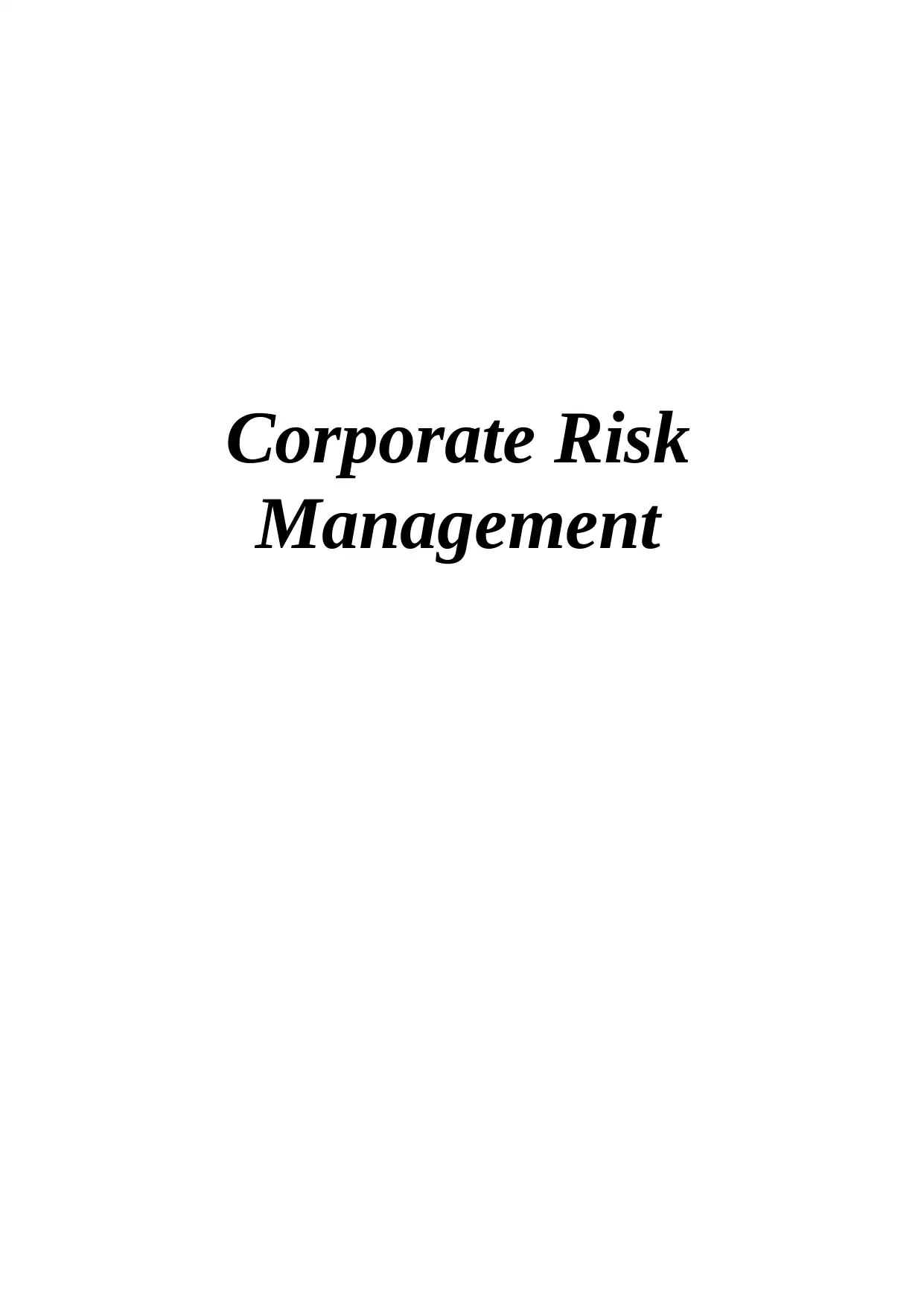
Corporate Risk
Management
Management
Paraphrase This Document
Need a fresh take? Get an instant paraphrase of this document with our AI Paraphraser
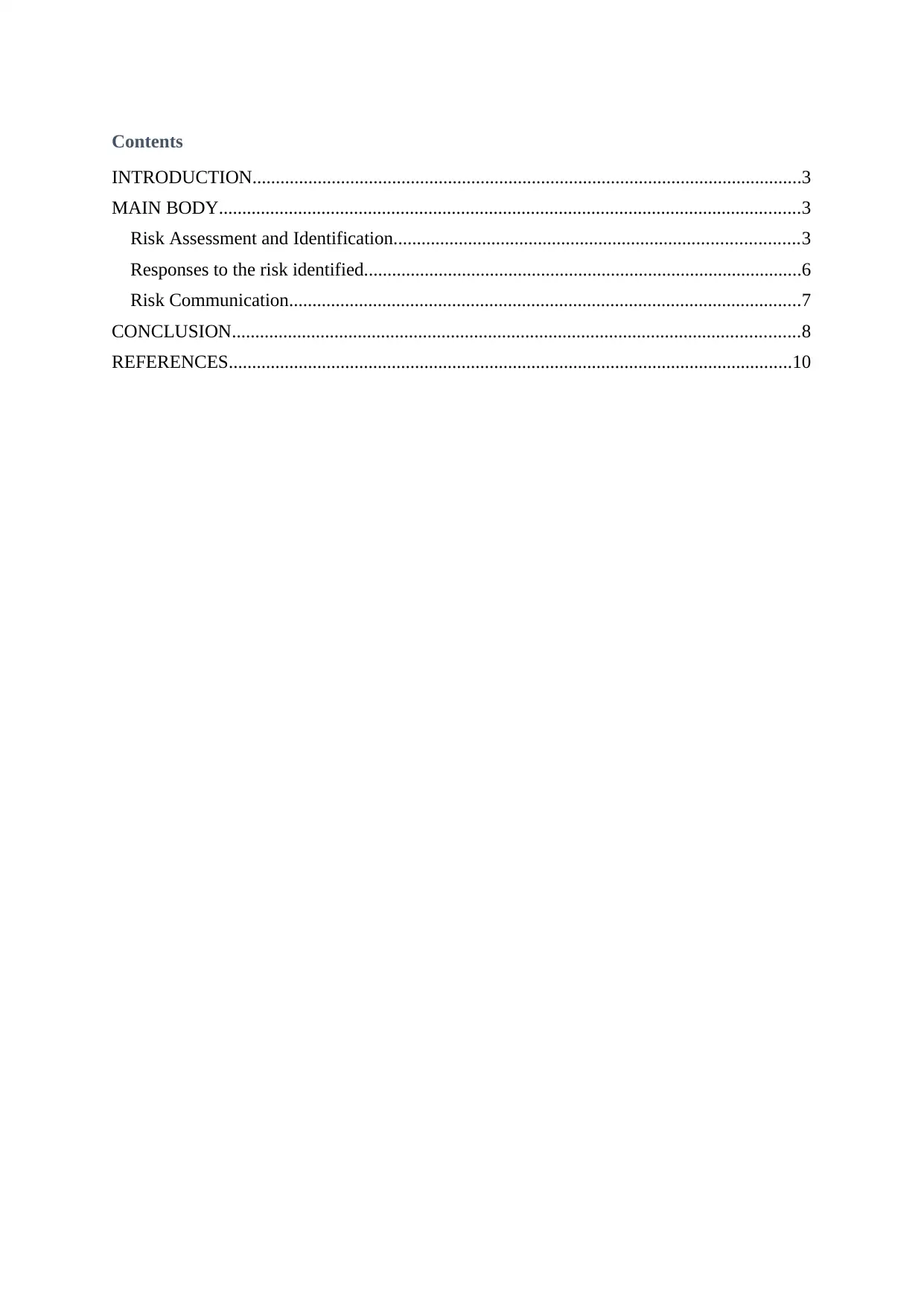
Contents
INTRODUCTION......................................................................................................................3
MAIN BODY.............................................................................................................................3
Risk Assessment and Identification.......................................................................................3
Responses to the risk identified..............................................................................................6
Risk Communication..............................................................................................................7
CONCLUSION..........................................................................................................................8
REFERENCES.........................................................................................................................10
INTRODUCTION......................................................................................................................3
MAIN BODY.............................................................................................................................3
Risk Assessment and Identification.......................................................................................3
Responses to the risk identified..............................................................................................6
Risk Communication..............................................................................................................7
CONCLUSION..........................................................................................................................8
REFERENCES.........................................................................................................................10
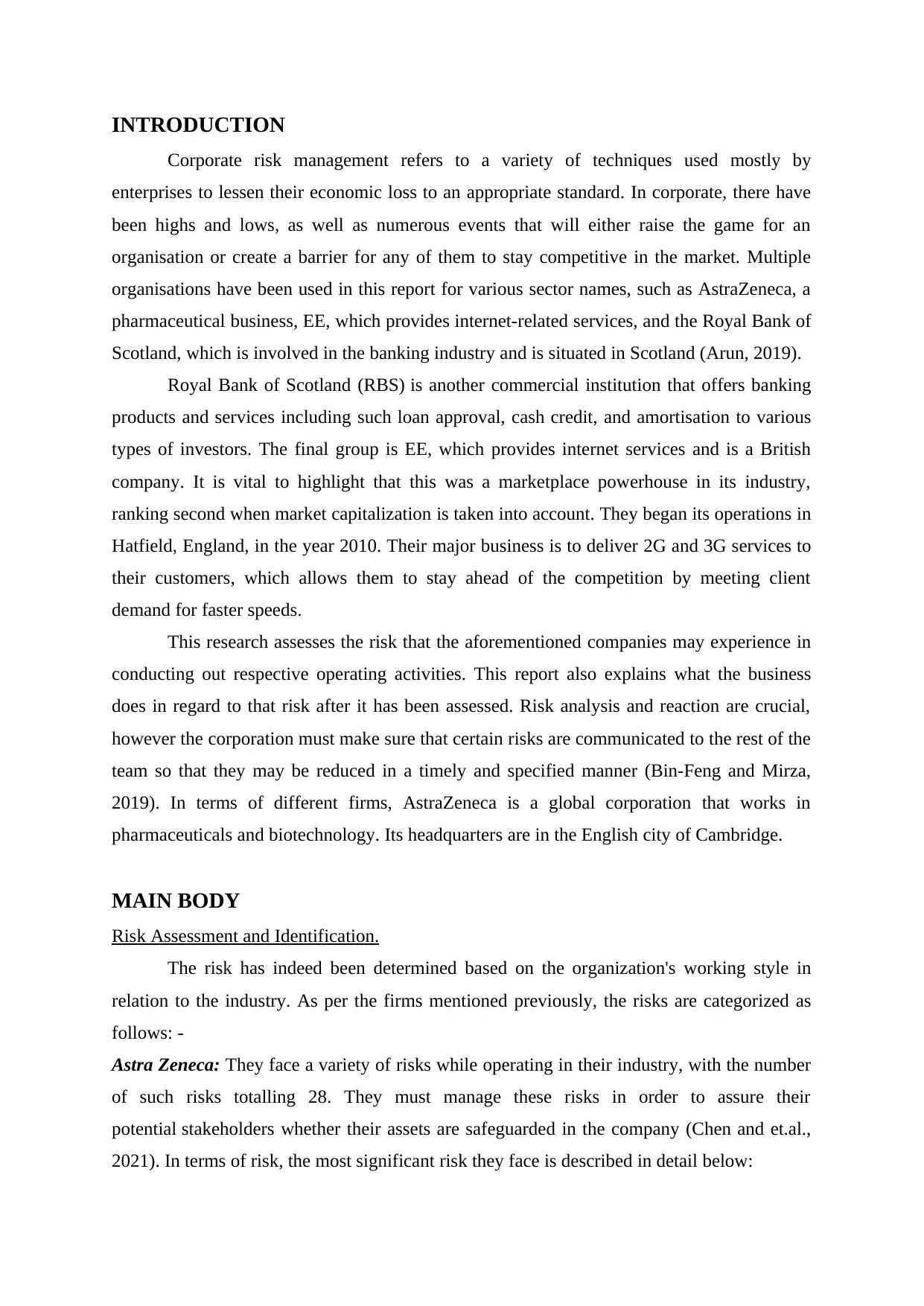
INTRODUCTION
Corporate risk management refers to a variety of techniques used mostly by
enterprises to lessen their economic loss to an appropriate standard. In corporate, there have
been highs and lows, as well as numerous events that will either raise the game for an
organisation or create a barrier for any of them to stay competitive in the market. Multiple
organisations have been used in this report for various sector names, such as AstraZeneca, a
pharmaceutical business, EE, which provides internet-related services, and the Royal Bank of
Scotland, which is involved in the banking industry and is situated in Scotland (Arun, 2019).
Royal Bank of Scotland (RBS) is another commercial institution that offers banking
products and services including such loan approval, cash credit, and amortisation to various
types of investors. The final group is EE, which provides internet services and is a British
company. It is vital to highlight that this was a marketplace powerhouse in its industry,
ranking second when market capitalization is taken into account. They began its operations in
Hatfield, England, in the year 2010. Their major business is to deliver 2G and 3G services to
their customers, which allows them to stay ahead of the competition by meeting client
demand for faster speeds.
This research assesses the risk that the aforementioned companies may experience in
conducting out respective operating activities. This report also explains what the business
does in regard to that risk after it has been assessed. Risk analysis and reaction are crucial,
however the corporation must make sure that certain risks are communicated to the rest of the
team so that they may be reduced in a timely and specified manner (Bin-Feng and Mirza,
2019). In terms of different firms, AstraZeneca is a global corporation that works in
pharmaceuticals and biotechnology. Its headquarters are in the English city of Cambridge.
MAIN BODY
Risk Assessment and Identification.
The risk has indeed been determined based on the organization's working style in
relation to the industry. As per the firms mentioned previously, the risks are categorized as
follows: -
Astra Zeneca: They face a variety of risks while operating in their industry, with the number
of such risks totalling 28. They must manage these risks in order to assure their
potential stakeholders whether their assets are safeguarded in the company (Chen and et.al.,
2021). In terms of risk, the most significant risk they face is described in detail below:
Corporate risk management refers to a variety of techniques used mostly by
enterprises to lessen their economic loss to an appropriate standard. In corporate, there have
been highs and lows, as well as numerous events that will either raise the game for an
organisation or create a barrier for any of them to stay competitive in the market. Multiple
organisations have been used in this report for various sector names, such as AstraZeneca, a
pharmaceutical business, EE, which provides internet-related services, and the Royal Bank of
Scotland, which is involved in the banking industry and is situated in Scotland (Arun, 2019).
Royal Bank of Scotland (RBS) is another commercial institution that offers banking
products and services including such loan approval, cash credit, and amortisation to various
types of investors. The final group is EE, which provides internet services and is a British
company. It is vital to highlight that this was a marketplace powerhouse in its industry,
ranking second when market capitalization is taken into account. They began its operations in
Hatfield, England, in the year 2010. Their major business is to deliver 2G and 3G services to
their customers, which allows them to stay ahead of the competition by meeting client
demand for faster speeds.
This research assesses the risk that the aforementioned companies may experience in
conducting out respective operating activities. This report also explains what the business
does in regard to that risk after it has been assessed. Risk analysis and reaction are crucial,
however the corporation must make sure that certain risks are communicated to the rest of the
team so that they may be reduced in a timely and specified manner (Bin-Feng and Mirza,
2019). In terms of different firms, AstraZeneca is a global corporation that works in
pharmaceuticals and biotechnology. Its headquarters are in the English city of Cambridge.
MAIN BODY
Risk Assessment and Identification.
The risk has indeed been determined based on the organization's working style in
relation to the industry. As per the firms mentioned previously, the risks are categorized as
follows: -
Astra Zeneca: They face a variety of risks while operating in their industry, with the number
of such risks totalling 28. They must manage these risks in order to assure their
potential stakeholders whether their assets are safeguarded in the company (Chen and et.al.,
2021). In terms of risk, the most significant risk they face is described in detail below:
⊘ This is a preview!⊘
Do you want full access?
Subscribe today to unlock all pages.

Trusted by 1+ million students worldwide
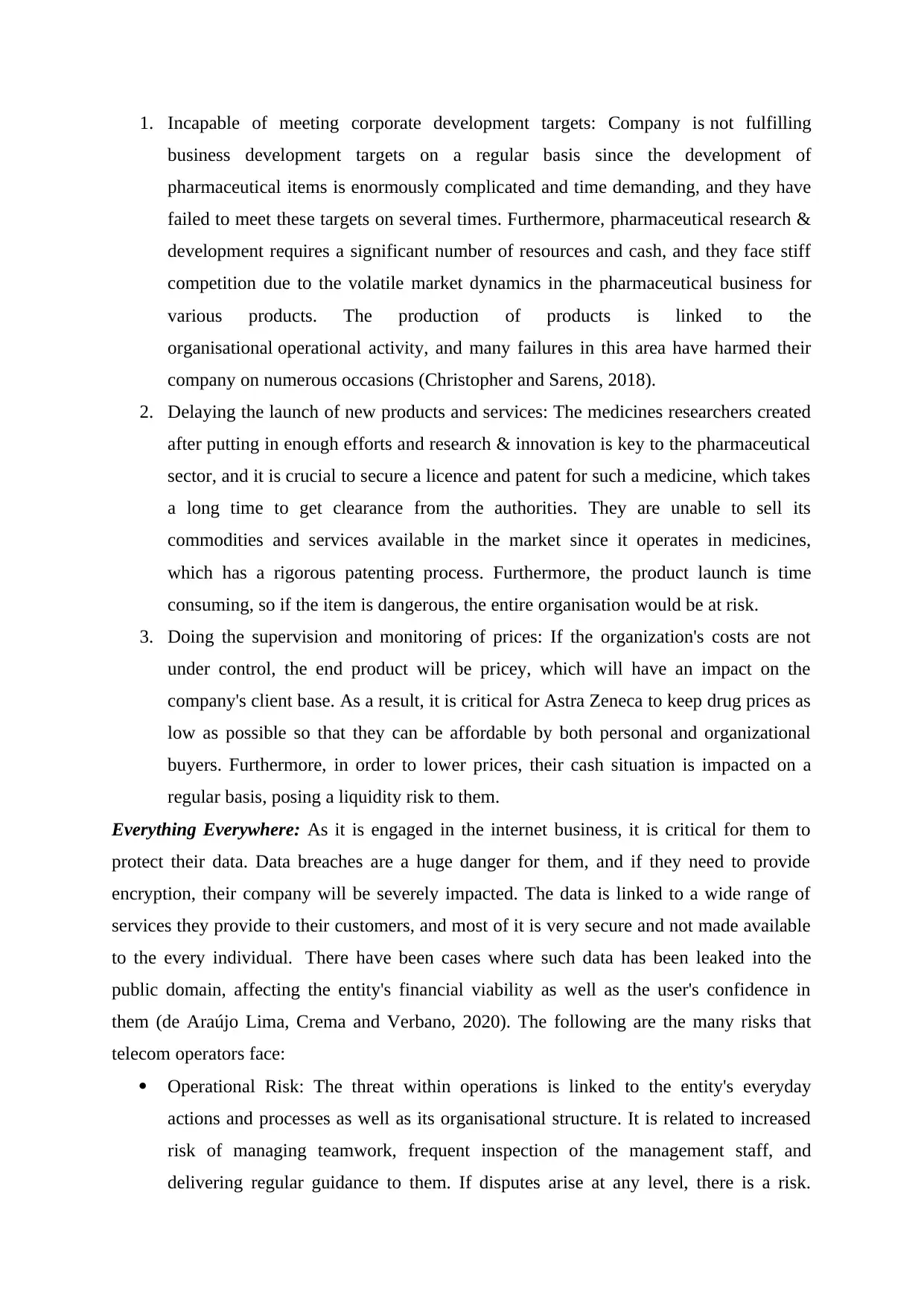
1. Incapable of meeting corporate development targets: Company is not fulfilling
business development targets on a regular basis since the development of
pharmaceutical items is enormously complicated and time demanding, and they have
failed to meet these targets on several times. Furthermore, pharmaceutical research &
development requires a significant number of resources and cash, and they face stiff
competition due to the volatile market dynamics in the pharmaceutical business for
various products. The production of products is linked to the
organisational operational activity, and many failures in this area have harmed their
company on numerous occasions (Christopher and Sarens, 2018).
2. Delaying the launch of new products and services: The medicines researchers created
after putting in enough efforts and research & innovation is key to the pharmaceutical
sector, and it is crucial to secure a licence and patent for such a medicine, which takes
a long time to get clearance from the authorities. They are unable to sell its
commodities and services available in the market since it operates in medicines,
which has a rigorous patenting process. Furthermore, the product launch is time
consuming, so if the item is dangerous, the entire organisation would be at risk.
3. Doing the supervision and monitoring of prices: If the organization's costs are not
under control, the end product will be pricey, which will have an impact on the
company's client base. As a result, it is critical for Astra Zeneca to keep drug prices as
low as possible so that they can be affordable by both personal and organizational
buyers. Furthermore, in order to lower prices, their cash situation is impacted on a
regular basis, posing a liquidity risk to them.
Everything Everywhere: As it is engaged in the internet business, it is critical for them to
protect their data. Data breaches are a huge danger for them, and if they need to provide
encryption, their company will be severely impacted. The data is linked to a wide range of
services they provide to their customers, and most of it is very secure and not made available
to the every individual. There have been cases where such data has been leaked into the
public domain, affecting the entity's financial viability as well as the user's confidence in
them (de Araújo Lima, Crema and Verbano, 2020). The following are the many risks that
telecom operators face:
Operational Risk: The threat within operations is linked to the entity's everyday
actions and processes as well as its organisational structure. It is related to increased
risk of managing teamwork, frequent inspection of the management staff, and
delivering regular guidance to them. If disputes arise at any level, there is a risk.
business development targets on a regular basis since the development of
pharmaceutical items is enormously complicated and time demanding, and they have
failed to meet these targets on several times. Furthermore, pharmaceutical research &
development requires a significant number of resources and cash, and they face stiff
competition due to the volatile market dynamics in the pharmaceutical business for
various products. The production of products is linked to the
organisational operational activity, and many failures in this area have harmed their
company on numerous occasions (Christopher and Sarens, 2018).
2. Delaying the launch of new products and services: The medicines researchers created
after putting in enough efforts and research & innovation is key to the pharmaceutical
sector, and it is crucial to secure a licence and patent for such a medicine, which takes
a long time to get clearance from the authorities. They are unable to sell its
commodities and services available in the market since it operates in medicines,
which has a rigorous patenting process. Furthermore, the product launch is time
consuming, so if the item is dangerous, the entire organisation would be at risk.
3. Doing the supervision and monitoring of prices: If the organization's costs are not
under control, the end product will be pricey, which will have an impact on the
company's client base. As a result, it is critical for Astra Zeneca to keep drug prices as
low as possible so that they can be affordable by both personal and organizational
buyers. Furthermore, in order to lower prices, their cash situation is impacted on a
regular basis, posing a liquidity risk to them.
Everything Everywhere: As it is engaged in the internet business, it is critical for them to
protect their data. Data breaches are a huge danger for them, and if they need to provide
encryption, their company will be severely impacted. The data is linked to a wide range of
services they provide to their customers, and most of it is very secure and not made available
to the every individual. There have been cases where such data has been leaked into the
public domain, affecting the entity's financial viability as well as the user's confidence in
them (de Araújo Lima, Crema and Verbano, 2020). The following are the many risks that
telecom operators face:
Operational Risk: The threat within operations is linked to the entity's everyday
actions and processes as well as its organisational structure. It is related to increased
risk of managing teamwork, frequent inspection of the management staff, and
delivering regular guidance to them. If disputes arise at any level, there is a risk.
Paraphrase This Document
Need a fresh take? Get an instant paraphrase of this document with our AI Paraphraser

Furthermore, if any troubleshooting issues arise during the system's assembly, the
system will fail.
Compliance Risk: This threat arises when a company refuses to follow certain
procedures linked to trade, and the telecommunications industry is heavily regulated.
The EE is governed by the Communication Act of 2003, and its rules and regulations
are highly tight, and if they do not follow them, they may face severe penalties. It is
critical for the company to follow legal compliance in order for commercial
operations to run effectively (Guan and Tang, 2018).
Financial Risk: It simply refers to an organization's incapacity to pay for supplies and
distribution that are related to the organisation for a longer length of time and help
them run the business. There is a risk of fraud and errors because many businesses use
the entity's franchise and then refuse to pay back the money.
Strategic Risk: This threat has arisen as a result of the influence of external
circumstances, which have an influence on the corporate's strategic vision. Any such
problem also exists when there is a shift in technology, which causes trouble for the
corporation and costs a lot of money because adopting latest tech is not easy (Zhai
and et.al., 2020).
Royal Bank of Scotland (RBS): The banking industry faces numerous risks, particularly with
respect to the loans it has sanctioned to its retail as well as other large commercial borrowers,
as there is a high possibility of debts or payment default by the customer. NPAs are a
challenge for the banking industry, but they also expose the bank to foreign exchange risk
due to payments made in the future. Because the bank works worldwide around the globe, it
is confronted with international practises issues. When a borrower's credit is evaluated and a
loan is approved, there is a chance that the funds will not be repaid by the due date. The bank
conducted a risk evaluation of their operational activities, which revealed that the bank
guarantee and numerous letters of credit provide adequate security for the monies they have
granted to its clients. The records they have preserved in tangible form to provide them with
enhanced protection in terms of protecting cash, as these paperwork comprises of all of the
important components on the base of which loans have been granted to individual and
corporate borrowers (Jiang and Feng, 2021). After evaluating the work that the Royal Bank
of Scotland has done, the risk that they face has been classified as follows:
The risk associated with money they have provided or authorized to customers upon
evaluating their financial capability, but it is possible that borrowers would be unable to settle
system will fail.
Compliance Risk: This threat arises when a company refuses to follow certain
procedures linked to trade, and the telecommunications industry is heavily regulated.
The EE is governed by the Communication Act of 2003, and its rules and regulations
are highly tight, and if they do not follow them, they may face severe penalties. It is
critical for the company to follow legal compliance in order for commercial
operations to run effectively (Guan and Tang, 2018).
Financial Risk: It simply refers to an organization's incapacity to pay for supplies and
distribution that are related to the organisation for a longer length of time and help
them run the business. There is a risk of fraud and errors because many businesses use
the entity's franchise and then refuse to pay back the money.
Strategic Risk: This threat has arisen as a result of the influence of external
circumstances, which have an influence on the corporate's strategic vision. Any such
problem also exists when there is a shift in technology, which causes trouble for the
corporation and costs a lot of money because adopting latest tech is not easy (Zhai
and et.al., 2020).
Royal Bank of Scotland (RBS): The banking industry faces numerous risks, particularly with
respect to the loans it has sanctioned to its retail as well as other large commercial borrowers,
as there is a high possibility of debts or payment default by the customer. NPAs are a
challenge for the banking industry, but they also expose the bank to foreign exchange risk
due to payments made in the future. Because the bank works worldwide around the globe, it
is confronted with international practises issues. When a borrower's credit is evaluated and a
loan is approved, there is a chance that the funds will not be repaid by the due date. The bank
conducted a risk evaluation of their operational activities, which revealed that the bank
guarantee and numerous letters of credit provide adequate security for the monies they have
granted to its clients. The records they have preserved in tangible form to provide them with
enhanced protection in terms of protecting cash, as these paperwork comprises of all of the
important components on the base of which loans have been granted to individual and
corporate borrowers (Jiang and Feng, 2021). After evaluating the work that the Royal Bank
of Scotland has done, the risk that they face has been classified as follows:
The risk associated with money they have provided or authorized to customers upon
evaluating their financial capability, but it is possible that borrowers would be unable to settle
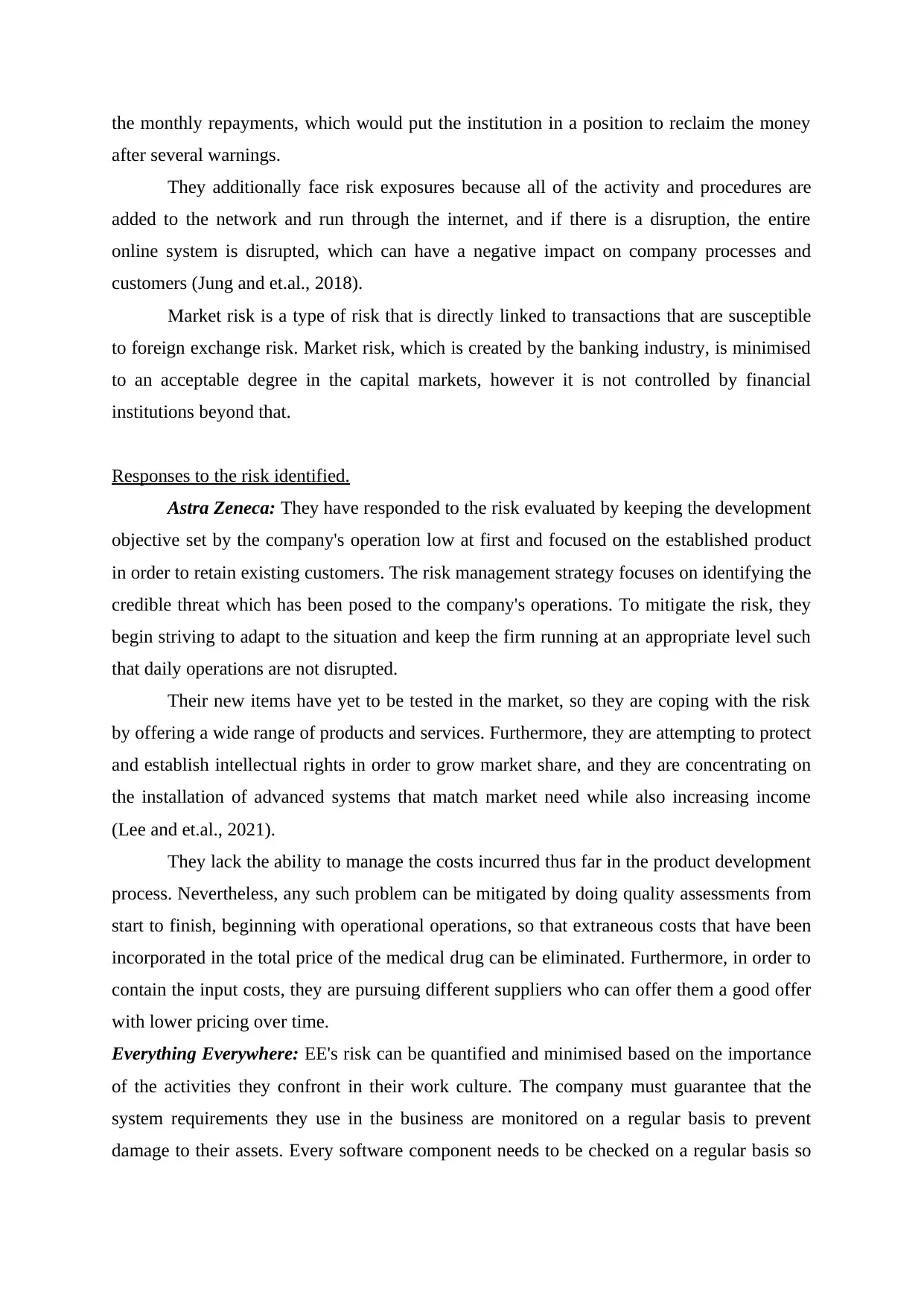
the monthly repayments, which would put the institution in a position to reclaim the money
after several warnings.
They additionally face risk exposures because all of the activity and procedures are
added to the network and run through the internet, and if there is a disruption, the entire
online system is disrupted, which can have a negative impact on company processes and
customers (Jung and et.al., 2018).
Market risk is a type of risk that is directly linked to transactions that are susceptible
to foreign exchange risk. Market risk, which is created by the banking industry, is minimised
to an acceptable degree in the capital markets, however it is not controlled by financial
institutions beyond that.
Responses to the risk identified.
Astra Zeneca: They have responded to the risk evaluated by keeping the development
objective set by the company's operation low at first and focused on the established product
in order to retain existing customers. The risk management strategy focuses on identifying the
credible threat which has been posed to the company's operations. To mitigate the risk, they
begin striving to adapt to the situation and keep the firm running at an appropriate level such
that daily operations are not disrupted.
Their new items have yet to be tested in the market, so they are coping with the risk
by offering a wide range of products and services. Furthermore, they are attempting to protect
and establish intellectual rights in order to grow market share, and they are concentrating on
the installation of advanced systems that match market need while also increasing income
(Lee and et.al., 2021).
They lack the ability to manage the costs incurred thus far in the product development
process. Nevertheless, any such problem can be mitigated by doing quality assessments from
start to finish, beginning with operational operations, so that extraneous costs that have been
incorporated in the total price of the medical drug can be eliminated. Furthermore, in order to
contain the input costs, they are pursuing different suppliers who can offer them a good offer
with lower pricing over time.
Everything Everywhere: EE's risk can be quantified and minimised based on the importance
of the activities they confront in their work culture. The company must guarantee that the
system requirements they use in the business are monitored on a regular basis to prevent
damage to their assets. Every software component needs to be checked on a regular basis so
after several warnings.
They additionally face risk exposures because all of the activity and procedures are
added to the network and run through the internet, and if there is a disruption, the entire
online system is disrupted, which can have a negative impact on company processes and
customers (Jung and et.al., 2018).
Market risk is a type of risk that is directly linked to transactions that are susceptible
to foreign exchange risk. Market risk, which is created by the banking industry, is minimised
to an acceptable degree in the capital markets, however it is not controlled by financial
institutions beyond that.
Responses to the risk identified.
Astra Zeneca: They have responded to the risk evaluated by keeping the development
objective set by the company's operation low at first and focused on the established product
in order to retain existing customers. The risk management strategy focuses on identifying the
credible threat which has been posed to the company's operations. To mitigate the risk, they
begin striving to adapt to the situation and keep the firm running at an appropriate level such
that daily operations are not disrupted.
Their new items have yet to be tested in the market, so they are coping with the risk
by offering a wide range of products and services. Furthermore, they are attempting to protect
and establish intellectual rights in order to grow market share, and they are concentrating on
the installation of advanced systems that match market need while also increasing income
(Lee and et.al., 2021).
They lack the ability to manage the costs incurred thus far in the product development
process. Nevertheless, any such problem can be mitigated by doing quality assessments from
start to finish, beginning with operational operations, so that extraneous costs that have been
incorporated in the total price of the medical drug can be eliminated. Furthermore, in order to
contain the input costs, they are pursuing different suppliers who can offer them a good offer
with lower pricing over time.
Everything Everywhere: EE's risk can be quantified and minimised based on the importance
of the activities they confront in their work culture. The company must guarantee that the
system requirements they use in the business are monitored on a regular basis to prevent
damage to their assets. Every software component needs to be checked on a regular basis so
⊘ This is a preview!⊘
Do you want full access?
Subscribe today to unlock all pages.

Trusted by 1+ million students worldwide
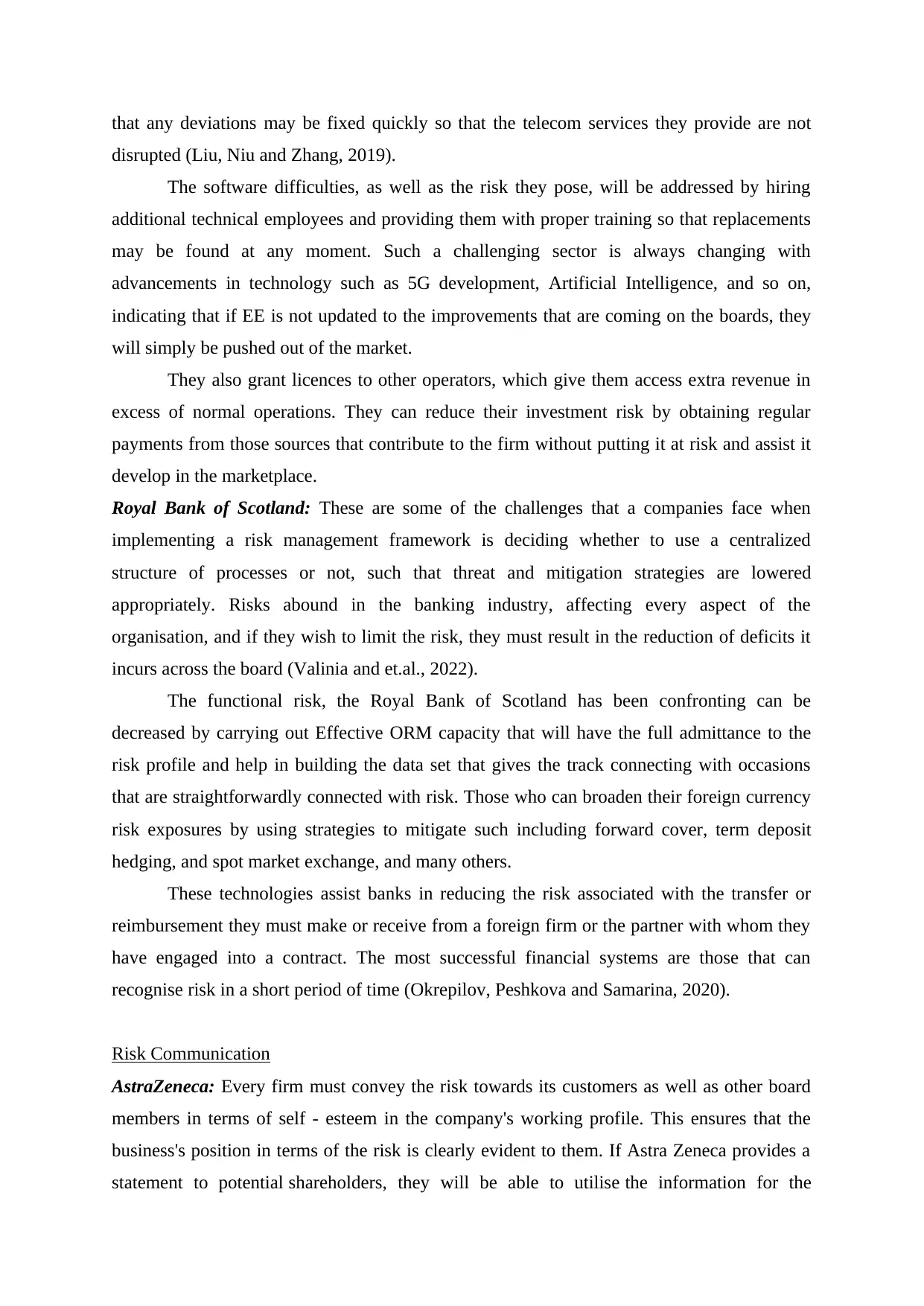
that any deviations may be fixed quickly so that the telecom services they provide are not
disrupted (Liu, Niu and Zhang, 2019).
The software difficulties, as well as the risk they pose, will be addressed by hiring
additional technical employees and providing them with proper training so that replacements
may be found at any moment. Such a challenging sector is always changing with
advancements in technology such as 5G development, Artificial Intelligence, and so on,
indicating that if EE is not updated to the improvements that are coming on the boards, they
will simply be pushed out of the market.
They also grant licences to other operators, which give them access extra revenue in
excess of normal operations. They can reduce their investment risk by obtaining regular
payments from those sources that contribute to the firm without putting it at risk and assist it
develop in the marketplace.
Royal Bank of Scotland: These are some of the challenges that a companies face when
implementing a risk management framework is deciding whether to use a centralized
structure of processes or not, such that threat and mitigation strategies are lowered
appropriately. Risks abound in the banking industry, affecting every aspect of the
organisation, and if they wish to limit the risk, they must result in the reduction of deficits it
incurs across the board (Valinia and et.al., 2022).
The functional risk, the Royal Bank of Scotland has been confronting can be
decreased by carrying out Effective ORM capacity that will have the full admittance to the
risk profile and help in building the data set that gives the track connecting with occasions
that are straightforwardly connected with risk. Those who can broaden their foreign currency
risk exposures by using strategies to mitigate such including forward cover, term deposit
hedging, and spot market exchange, and many others.
These technologies assist banks in reducing the risk associated with the transfer or
reimbursement they must make or receive from a foreign firm or the partner with whom they
have engaged into a contract. The most successful financial systems are those that can
recognise risk in a short period of time (Okrepilov, Peshkova and Samarina, 2020).
Risk Communication
AstraZeneca: Every firm must convey the risk towards its customers as well as other board
members in terms of self - esteem in the company's working profile. This ensures that the
business's position in terms of the risk is clearly evident to them. If Astra Zeneca provides a
statement to potential shareholders, they will be able to utilise the information for the
disrupted (Liu, Niu and Zhang, 2019).
The software difficulties, as well as the risk they pose, will be addressed by hiring
additional technical employees and providing them with proper training so that replacements
may be found at any moment. Such a challenging sector is always changing with
advancements in technology such as 5G development, Artificial Intelligence, and so on,
indicating that if EE is not updated to the improvements that are coming on the boards, they
will simply be pushed out of the market.
They also grant licences to other operators, which give them access extra revenue in
excess of normal operations. They can reduce their investment risk by obtaining regular
payments from those sources that contribute to the firm without putting it at risk and assist it
develop in the marketplace.
Royal Bank of Scotland: These are some of the challenges that a companies face when
implementing a risk management framework is deciding whether to use a centralized
structure of processes or not, such that threat and mitigation strategies are lowered
appropriately. Risks abound in the banking industry, affecting every aspect of the
organisation, and if they wish to limit the risk, they must result in the reduction of deficits it
incurs across the board (Valinia and et.al., 2022).
The functional risk, the Royal Bank of Scotland has been confronting can be
decreased by carrying out Effective ORM capacity that will have the full admittance to the
risk profile and help in building the data set that gives the track connecting with occasions
that are straightforwardly connected with risk. Those who can broaden their foreign currency
risk exposures by using strategies to mitigate such including forward cover, term deposit
hedging, and spot market exchange, and many others.
These technologies assist banks in reducing the risk associated with the transfer or
reimbursement they must make or receive from a foreign firm or the partner with whom they
have engaged into a contract. The most successful financial systems are those that can
recognise risk in a short period of time (Okrepilov, Peshkova and Samarina, 2020).
Risk Communication
AstraZeneca: Every firm must convey the risk towards its customers as well as other board
members in terms of self - esteem in the company's working profile. This ensures that the
business's position in terms of the risk is clearly evident to them. If Astra Zeneca provides a
statement to potential shareholders, they will be able to utilise the information for the
Paraphrase This Document
Need a fresh take? Get an instant paraphrase of this document with our AI Paraphraser

company's benefit. Various reports also contain a sustainability report that they must produce
that is relevant to Astra Zeneca's strategy and governance. In addition, they contain any
mergers and acquisitions that occurred during the operative year. Various company strategies
and working styles have been outlined in order for stakeholders and customers of Astra
Zeneca to see them as members of the corporation and guides the firm when they are in need
(Olson and et.al., 2021).
Everything Everywhere: EE's stakeholders utilise the data in their own unique ways to
ensure that the organisation is operating in accordance with the ethics and goals they
established at the outset. Risk communication is required so that members may quickly
comprehend performance and deviations in work. Such risk is conveyed so that investors are
aware of the risk that the organisation has been exposed to and can invest their funds
accordingly, depending on the risk structure that they are managing. The risk they face could
be the installation of signal networks, circuits, and other equipment that carries a higher risk
and can have major health consequences for employees and workers.
RBS: It is vital for the banking firm to disclose significant associated risks to the bank's
membership and owners in order to aid in the development of strong relationships among
them and the community, which applies to all employees, the authorities, suppliers, and
creditors, among others. RBS must not only communicate risks, but also provide suitable
safety for such resources they employ to ensure that they are not misappropriated by outsider
attacks. Since exterior investors will be looking at the banks’ financial performance over a
lengthy period of time, risk communication is essential (Poluektova, Klebanova and
Guryanova, 2018).
CONCLUSION
The conclusion obtained from the aforementioned analysis is that risk analysis and
prompt reaction are critical for mitigating business risk in a timely manner. Every industry is
exposed to some level of risk, which must be mitigated in order for corporate operations to
continue uninterrupted. Three separate entities have been established in this research, along
with their related risk. Based on the identification of such risk variables, the organisations'
responses to those risks have been detailed. Communication of such risks to relevant
administration has been emphasised in detail at the end of this report. The sorts of risk that a
corporation experiences in their operational business, as well as how such risk presents a
barrier for them, have been comprehensively covered in this report. The three companies that
that is relevant to Astra Zeneca's strategy and governance. In addition, they contain any
mergers and acquisitions that occurred during the operative year. Various company strategies
and working styles have been outlined in order for stakeholders and customers of Astra
Zeneca to see them as members of the corporation and guides the firm when they are in need
(Olson and et.al., 2021).
Everything Everywhere: EE's stakeholders utilise the data in their own unique ways to
ensure that the organisation is operating in accordance with the ethics and goals they
established at the outset. Risk communication is required so that members may quickly
comprehend performance and deviations in work. Such risk is conveyed so that investors are
aware of the risk that the organisation has been exposed to and can invest their funds
accordingly, depending on the risk structure that they are managing. The risk they face could
be the installation of signal networks, circuits, and other equipment that carries a higher risk
and can have major health consequences for employees and workers.
RBS: It is vital for the banking firm to disclose significant associated risks to the bank's
membership and owners in order to aid in the development of strong relationships among
them and the community, which applies to all employees, the authorities, suppliers, and
creditors, among others. RBS must not only communicate risks, but also provide suitable
safety for such resources they employ to ensure that they are not misappropriated by outsider
attacks. Since exterior investors will be looking at the banks’ financial performance over a
lengthy period of time, risk communication is essential (Poluektova, Klebanova and
Guryanova, 2018).
CONCLUSION
The conclusion obtained from the aforementioned analysis is that risk analysis and
prompt reaction are critical for mitigating business risk in a timely manner. Every industry is
exposed to some level of risk, which must be mitigated in order for corporate operations to
continue uninterrupted. Three separate entities have been established in this research, along
with their related risk. Based on the identification of such risk variables, the organisations'
responses to those risks have been detailed. Communication of such risks to relevant
administration has been emphasised in detail at the end of this report. The sorts of risk that a
corporation experiences in their operational business, as well as how such risk presents a
barrier for them, have been comprehensively covered in this report. The three companies that

have been examined are Astra Zeneca, which is a pharmaceutical company, Everything
Everywhere, which is an internet service provider, and RBS, which is in the banking sector,
and the risks that these companies face have been detailed in the paper described above.
Everywhere, which is an internet service provider, and RBS, which is in the banking sector,
and the risks that these companies face have been detailed in the paper described above.
⊘ This is a preview!⊘
Do you want full access?
Subscribe today to unlock all pages.

Trusted by 1+ million students worldwide
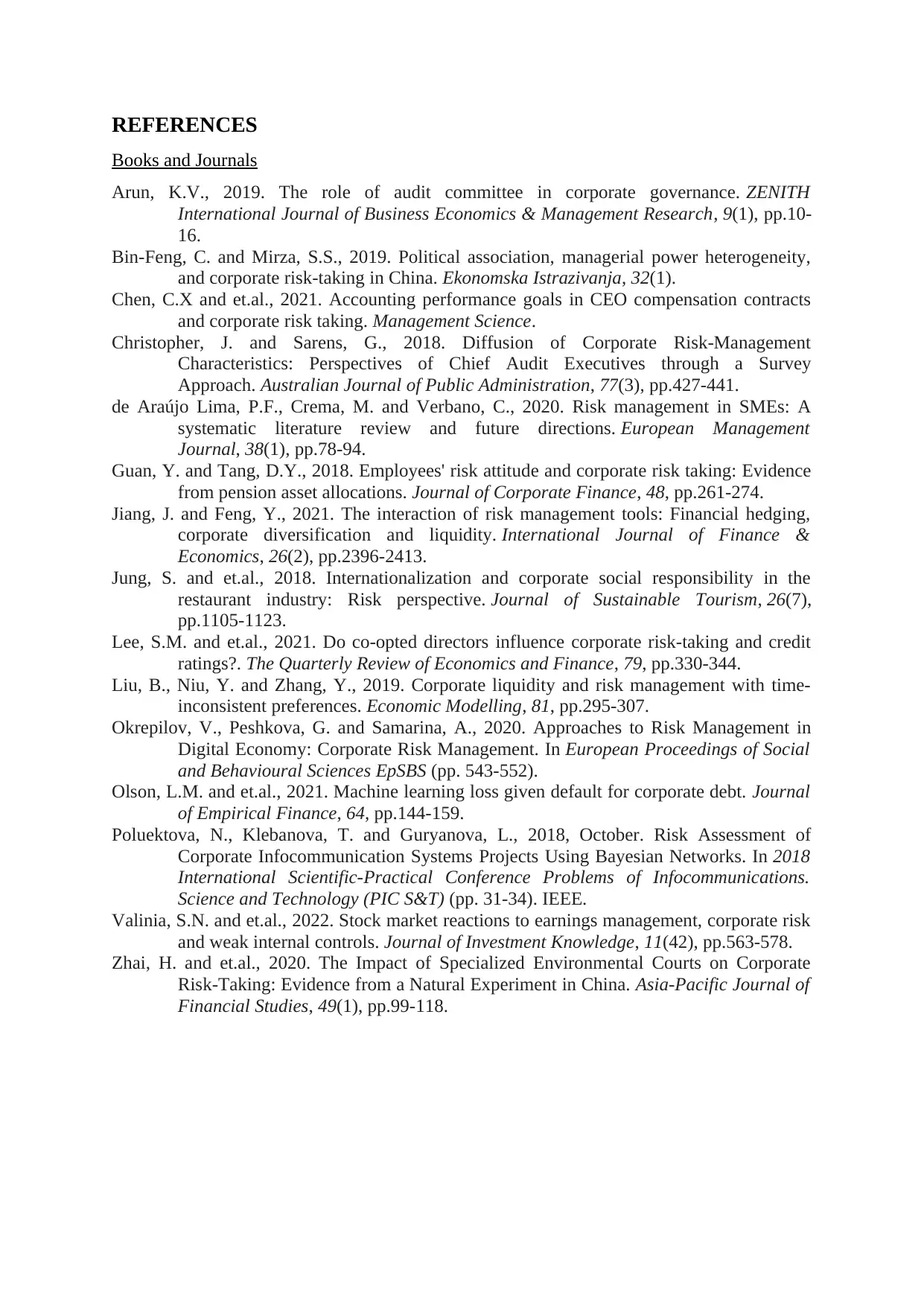
REFERENCES
Books and Journals
Arun, K.V., 2019. The role of audit committee in corporate governance. ZENITH
International Journal of Business Economics & Management Research, 9(1), pp.10-
16.
Bin-Feng, C. and Mirza, S.S., 2019. Political association, managerial power heterogeneity,
and corporate risk-taking in China. Ekonomska Istrazivanja, 32(1).
Chen, C.X and et.al., 2021. Accounting performance goals in CEO compensation contracts
and corporate risk taking. Management Science.
Christopher, J. and Sarens, G., 2018. Diffusion of Corporate Risk‐Management
Characteristics: Perspectives of Chief Audit Executives through a Survey
Approach. Australian Journal of Public Administration, 77(3), pp.427-441.
de Araújo Lima, P.F., Crema, M. and Verbano, C., 2020. Risk management in SMEs: A
systematic literature review and future directions. European Management
Journal, 38(1), pp.78-94.
Guan, Y. and Tang, D.Y., 2018. Employees' risk attitude and corporate risk taking: Evidence
from pension asset allocations. Journal of Corporate Finance, 48, pp.261-274.
Jiang, J. and Feng, Y., 2021. The interaction of risk management tools: Financial hedging,
corporate diversification and liquidity. International Journal of Finance &
Economics, 26(2), pp.2396-2413.
Jung, S. and et.al., 2018. Internationalization and corporate social responsibility in the
restaurant industry: Risk perspective. Journal of Sustainable Tourism, 26(7),
pp.1105-1123.
Lee, S.M. and et.al., 2021. Do co-opted directors influence corporate risk-taking and credit
ratings?. The Quarterly Review of Economics and Finance, 79, pp.330-344.
Liu, B., Niu, Y. and Zhang, Y., 2019. Corporate liquidity and risk management with time-
inconsistent preferences. Economic Modelling, 81, pp.295-307.
Okrepilov, V., Peshkova, G. and Samarina, A., 2020. Approaches to Risk Management in
Digital Economy: Corporate Risk Management. In European Proceedings of Social
and Behavioural Sciences EpSBS (pp. 543-552).
Olson, L.M. and et.al., 2021. Machine learning loss given default for corporate debt. Journal
of Empirical Finance, 64, pp.144-159.
Poluektova, N., Klebanova, T. and Guryanova, L., 2018, October. Risk Assessment of
Corporate Infocommunication Systems Projects Using Bayesian Networks. In 2018
International Scientific-Practical Conference Problems of Infocommunications.
Science and Technology (PIC S&T) (pp. 31-34). IEEE.
Valinia, S.N. and et.al., 2022. Stock market reactions to earnings management, corporate risk
and weak internal controls. Journal of Investment Knowledge, 11(42), pp.563-578.
Zhai, H. and et.al., 2020. The Impact of Specialized Environmental Courts on Corporate
Risk‐Taking: Evidence from a Natural Experiment in China. Asia‐Pacific Journal of
Financial Studies, 49(1), pp.99-118.
Books and Journals
Arun, K.V., 2019. The role of audit committee in corporate governance. ZENITH
International Journal of Business Economics & Management Research, 9(1), pp.10-
16.
Bin-Feng, C. and Mirza, S.S., 2019. Political association, managerial power heterogeneity,
and corporate risk-taking in China. Ekonomska Istrazivanja, 32(1).
Chen, C.X and et.al., 2021. Accounting performance goals in CEO compensation contracts
and corporate risk taking. Management Science.
Christopher, J. and Sarens, G., 2018. Diffusion of Corporate Risk‐Management
Characteristics: Perspectives of Chief Audit Executives through a Survey
Approach. Australian Journal of Public Administration, 77(3), pp.427-441.
de Araújo Lima, P.F., Crema, M. and Verbano, C., 2020. Risk management in SMEs: A
systematic literature review and future directions. European Management
Journal, 38(1), pp.78-94.
Guan, Y. and Tang, D.Y., 2018. Employees' risk attitude and corporate risk taking: Evidence
from pension asset allocations. Journal of Corporate Finance, 48, pp.261-274.
Jiang, J. and Feng, Y., 2021. The interaction of risk management tools: Financial hedging,
corporate diversification and liquidity. International Journal of Finance &
Economics, 26(2), pp.2396-2413.
Jung, S. and et.al., 2018. Internationalization and corporate social responsibility in the
restaurant industry: Risk perspective. Journal of Sustainable Tourism, 26(7),
pp.1105-1123.
Lee, S.M. and et.al., 2021. Do co-opted directors influence corporate risk-taking and credit
ratings?. The Quarterly Review of Economics and Finance, 79, pp.330-344.
Liu, B., Niu, Y. and Zhang, Y., 2019. Corporate liquidity and risk management with time-
inconsistent preferences. Economic Modelling, 81, pp.295-307.
Okrepilov, V., Peshkova, G. and Samarina, A., 2020. Approaches to Risk Management in
Digital Economy: Corporate Risk Management. In European Proceedings of Social
and Behavioural Sciences EpSBS (pp. 543-552).
Olson, L.M. and et.al., 2021. Machine learning loss given default for corporate debt. Journal
of Empirical Finance, 64, pp.144-159.
Poluektova, N., Klebanova, T. and Guryanova, L., 2018, October. Risk Assessment of
Corporate Infocommunication Systems Projects Using Bayesian Networks. In 2018
International Scientific-Practical Conference Problems of Infocommunications.
Science and Technology (PIC S&T) (pp. 31-34). IEEE.
Valinia, S.N. and et.al., 2022. Stock market reactions to earnings management, corporate risk
and weak internal controls. Journal of Investment Knowledge, 11(42), pp.563-578.
Zhai, H. and et.al., 2020. The Impact of Specialized Environmental Courts on Corporate
Risk‐Taking: Evidence from a Natural Experiment in China. Asia‐Pacific Journal of
Financial Studies, 49(1), pp.99-118.
1 out of 10
Related Documents
Your All-in-One AI-Powered Toolkit for Academic Success.
+13062052269
info@desklib.com
Available 24*7 on WhatsApp / Email
![[object Object]](/_next/static/media/star-bottom.7253800d.svg)
Unlock your academic potential
Copyright © 2020–2025 A2Z Services. All Rights Reserved. Developed and managed by ZUCOL.
